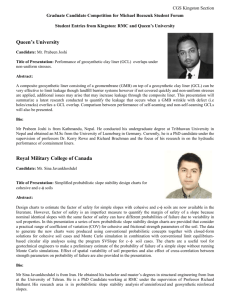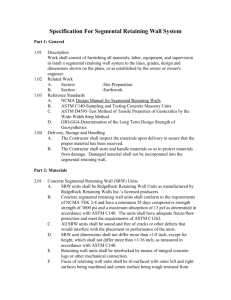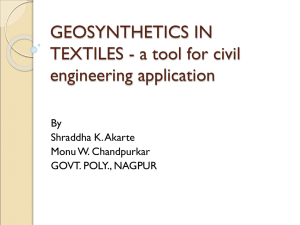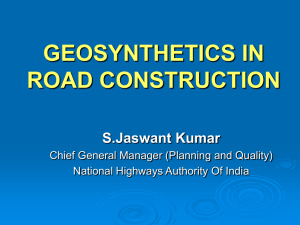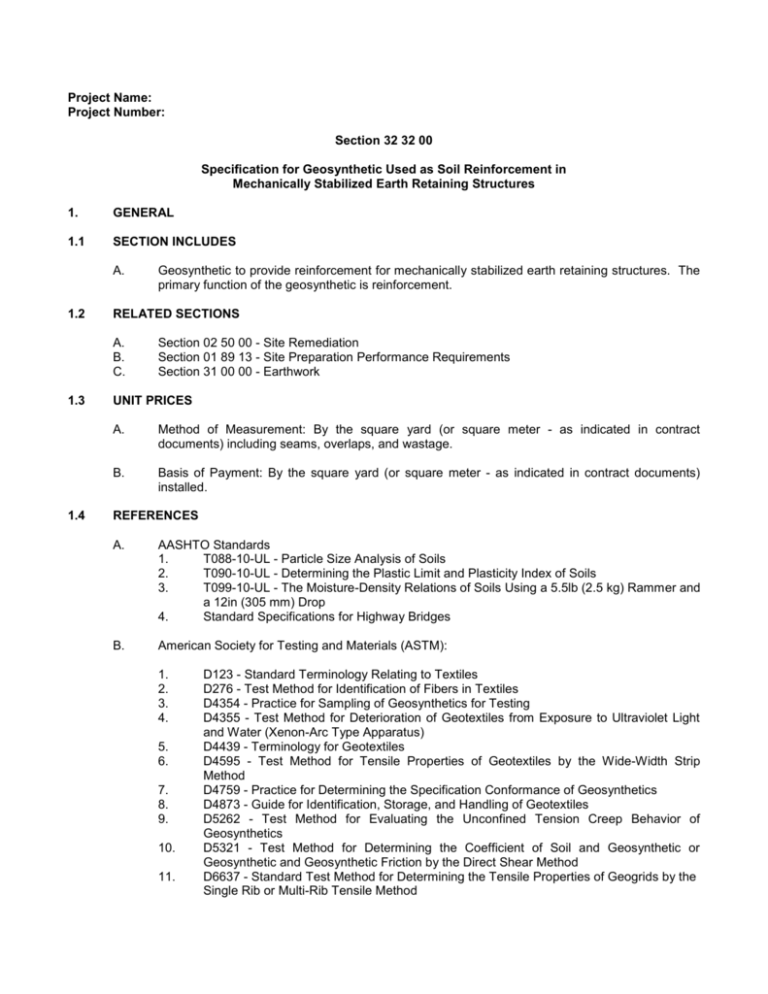
Project Name:
Project Number:
Section 32 32 00
Specification for Geosynthetic Used as Soil Reinforcement in
Mechanically Stabilized Earth Retaining Structures
1.
GENERAL
1.1
SECTION INCLUDES
A.
1.2
RELATED SECTIONS
A.
B.
C.
1.3
1.4
Geosynthetic to provide reinforcement for mechanically stabilized earth retaining structures. The
primary function of the geosynthetic is reinforcement.
Section 02 50 00 - Site Remediation
Section 01 89 13 - Site Preparation Performance Requirements
Section 31 00 00 - Earthwork
UNIT PRICES
A.
Method of Measurement: By the square yard (or square meter - as indicated in contract
documents) including seams, overlaps, and wastage.
B.
Basis of Payment: By the square yard (or square meter - as indicated in contract documents)
installed.
REFERENCES
A.
AASHTO Standards
1.
T088-10-UL - Particle Size Analysis of Soils
2.
T090-10-UL - Determining the Plastic Limit and Plasticity Index of Soils
3.
T099-10-UL - The Moisture-Density Relations of Soils Using a 5.5lb (2.5 kg) Rammer and
a 12in (305 mm) Drop
4.
Standard Specifications for Highway Bridges
B.
American Society for Testing and Materials (ASTM):
1.
2.
3.
4.
5.
6.
7.
8.
9.
10.
11.
D123 - Standard Terminology Relating to Textiles
D276 - Test Method for Identification of Fibers in Textiles
D4354 - Practice for Sampling of Geosynthetics for Testing
D4355 - Test Method for Deterioration of Geotextiles from Exposure to Ultraviolet Light
and Water (Xenon-Arc Type Apparatus)
D4439 - Terminology for Geotextiles
D4595 - Test Method for Tensile Properties of Geotextiles by the Wide-Width Strip
Method
D4759 - Practice for Determining the Specification Conformance of Geosynthetics
D4873 - Guide for Identification, Storage, and Handling of Geotextiles
D5262 - Test Method for Evaluating the Unconfined Tension Creep Behavior of
Geosynthetics
D5321 - Test Method for Determining the Coefficient of Soil and Geosynthetic or
Geosynthetic and Geosynthetic Friction by the Direct Shear Method
D6637 - Standard Test Method for Determining the Tensile Properties of Geogrids by the
Single Rib or Multi-Rib Tensile Method
B.
National Concrete Masonry Association (NCMA) - Design Manual for Segmental Retaining Walls,
Second Edition, 1997.
C.
Geosynthetic Research Institute:
1.
GRI-GT6 - Geotextile Pullout
2.
GRI-GT7 - Determination of the Long-Term Design Strength of Geotextiles
3.
GRI-GG4 (b) - Determination of the Long-Term Design Strength of Flexible Geogrids
4.
GRI-GG5 - Test Method for Geogrid Pullout
5.
GRI-GG7 - Carboxyl End Group Content of PET Yarns
6.
GRI-GG8 - Determination of the Number Average Molecular Weight of PET Yarns Based
on a Relative Viscosity Value
D.
Federal Highway Administration (FHWA)
1.
2.
1.5
E.
American Association for Laboratory Accreditation (A2LA)
F.
Geosynthetic Accreditation Institute (GAI) - Laboratory Accreditation Program (LAP).
G.
National Transportation Product Evaluation Program (NTPEP)
H.
International Standards Organization (ISO) – 9001:2008
DEFINITIONS
A.
1.6
FHWA SA-96-071 - Mechanically Stabilized Earth Walls and Reinforced Soil Slopes
Design and Construction Guidelines
FHWA SA-96-072 - Corrosion/Degradation of Soil Reinforcements for Mechanically
Stabilized Earth Walls and Reinforced Soil Slopes
Minimum Average Roll Value (MARV): Property value calculated as typical minus two standard
deviations. Statistically, it yields a 97.7 percent degree of confidence that any sample taken
during quality assurance testing will exceed value reported.
SUBMITTALS
A.
Submit the following:
1.
Certification: The contractor shall provide to the Engineer a certificate stating the name
of the manufacturer, product name, style number, chemical composition of the filaments
or yarns and other pertinent information to fully describe the geosynthetic. The
Certification shall state that the furnished geosynthetic meets MARV requirements of the
specification as evaluated under the Manufacturer's quality control program. The
Certification shall be attested to by a person having legal authority to bind the
Manufacturer.
2.
Quality Standards: The contractor shall provide to the Engineer the manufacturer’s
Quality Control Plan along with their current A2LA, GAI-LAP, and ISO 9001:2008
certificates.
1.7
QUALITY ASSURANCE
A.
Manufacturer Qualifications:
1.
The geotextile manufacturer shall have all of the following credentials:
a. Geosynthetic Accreditation Institute (GAI) - Laboratory Accreditation Program (LAP)
b. American Association for Laboratory Accreditation (A2LA)
c.
B.
1.8
ISO 9001:2008 Quality Management System
The geotextile manufacturer shall have a GAI-LAP accredited laboratory at the location of
production capable of performing the ASTM tests as outlined in the specification.
DELIVERY, STORAGE, AND HANDLING
A.
Geosynthetic labeling, shipment, and storage shall follow ASTM D4873. Product labels shall
clearly show the manufacturer or supplier name, style name, and roll number.
B.
Each geosynthetic roll shall be wrapped with a material that will protect the geosynthetic from
damage due to shipment, water, sunlight, and contaminants.
C.
During storage, geosynthetic rolls shall be elevated off the ground and adequately covered to
protect them from the following: site construction damage, precipitation, extended ultraviolet
radiation including sunlight, chemicals that are strong acids or strong bases, flames including
welding sparks, excess temperatures, and any other environmental conditions that may damage
the physical property values of the geosynthetic.
2.
PRODUCTS
2.1
MANUFACTURERS
A.
2.2
TenCate Geosynthetics Americas
365 South Holland Drive
Pendergrass, GA, USA 30567
1-800-685-9990
1-706-693-2226
1-706-693-2083, fax
www.mirafi.com
MATERIALS
A.
Reinforcement Geosynthetics:
1.
The geosynthetic shall be manufactured with fibers consisting of long-chain synthetic
polymers composed of at least 95 percent by weight of polyolefins or polyesters. They
shall form a stable network such that the filaments or yarns retain their dimensional
stability relative to each other, including selvages.
2.
The geosynthetic shall meet the requirements of Table 1. All numeric values in Table 1
represent MARV in the principal reinforcement direction.
TABLE 1 - REINFORCEMENT GEOGRIDS
Property1
Tult2
LTDS3
(Sand)
LTDS3
(Sandy
Gravel)
LTDS3
(Gravel)
Units
kN/m
(lbs/ft)
kN/m
(lbs/ft)
S1
29.2
(2000)
15.8
(1082)
P1
51.1
(3500)
28.0
(1918)
P2
68.6
(4700)
37.6
(2575)
P3
86.1
(5900)
47.2
(3233)
P4
108.0
(7400)
59.2
(4055)
P5
138.6
(9500)
76.0
(5206)
P6
181.2
(12420)
99.3
(6805)
P7
259.1
(17760)
142.0
(9732)
kN/m
(lbs/ft)
15.1
(1033)
26.7
(1831)
35.9
(2458)
45.0
(3086)
56.5
(3871)
72.5
(4969)
94.8
(6496)
135.5
(9289)
kN/m
(lbs/ft)
11.1
(758)
23.5
(1611)
231.6
(2163)
39.6
(2716)
49.7
(3406)
63.8
(4373)
83.4
(5717)
119.3
(8175)
1
Values listed for Type S1 is for machine and cross-machine directions. Values listed for Types P1, P2, P3,
P4, P5, P6, P7 are machine direction only.
2
TULT shall be the minimum average roll value (MARV) ultimate tensile strength as tested per ASTM D6637.
3
Tal or LTDS, are determined per AASHTO, FHWA, GRI, and NCMA guidelines where LTDS =
TULT/(RFCRxRFIDxRFD).
3.
Approved geosynthetics are as follows:
Type S1:
Type P1:
Type P2:
Type P3:
Type P4:
Type P5:
Type P6:
Type P7:
4.
Miragrid 2XT
Miragrid 3XT
Miragrid 5XT
Miragrid 7XT
Miragrid 8XT
Miragrid 10XT
Miragrid 20XT
Miragrid 22XT
Long-Term Design Strength (LTDS) and Allowable Tensile Strength (T a) are determined
per AASHTO, FHWA, GRI, and NCMA guidelines where;
LTDS =
TULT
RFCR RFID RFD
a.
TULT, Ultimate Tensile Strength, shall be the minimum average roll value (MARV)
ultimate tensile strength as tested per ASTM D6637.
b.
RFCR, Reduction Factor for Creep Deformation, is the ratio of T ULT to creep
limited strength determined in accordance with ASTM D5262. The results shall
be extrapolated for a 75 year design life using elevated temperature and/or
stress rupture testing for 10,000 hours or room temperature testing for 65,700
hours per GRI-GG4 (b). Total reinforcement strain shall be less than 10% over
the 75-year design life. A minimum RFCR shall be as follows:
Polymer Type
Polyester
High Density Polyethylene
Polypropylene
RFCR
1.58
2.6
4.0
5.
c.
RFID, Reduction Factor for Installation Damage, shall be determined from
construction damage tests for each product or product family proposed for use
with project specific, representative or more severe backfill materials and
construction techniques. Testing shall be consistent with GRI-GG4 (b). A default
RFID value of 2.0 shall be used if such testing has not been conducted. A
minimum RFID shall be 1.05.
d.
RFD, Reduction Factor for Durability, shall be based on polyester yarn testing per
FHWA durability guidelines. Polyester yarns shall have a Molecular Weight >
25,000 g/m per GRI-GG8 and a carboxyl end group number < 30 per GRI-GG7.
A default RFD value of 3.0 shall be used if polyester yarns do not meet these
requirements. A minimum RFD shall be 1.10.
Soil Interaction Coefficient, Ci value shall be determined from short-term effective stress
pullout tests per GRI-GG5 or GRI-GT6 over the range of normal stresses encountered.
The maximum pullout force used to determine Ci shall be limited to the lessor of Ta or the
force that yields 1.5 inches displacement. The minimum Ci value shall not be less than
0.7, determined as follows:
Ci =
F
2LσN tanφ
where F =
L =
σN =
φ =
6.
.
Pullout Force (lb/ft), per GRI-GG5 or GRI-GT6
Geosynthetic Embedment Length in Test (ft)
Effective Normal Stress (psf)
Effective Soil Friction Angle, Degrees
Direct Sliding Coefficient, Cds value shall be determined in accordance with ASTM D5321
over the range of normal stresses encountered. The minimum C ds value shall not be less
than 0.7, determined as follows:
Cds =
Rds
L σN tanφ
.
where Rds = Maximum Shear Resistance (lb/ft), per ASTM D5321
L = Stationary Length of Geosynthetic (ft)
σN = Effective Normal Stress (psf)
φ = Effective Soil Friction Angle, Degrees
7.
2.3
UV Resistance shall be determined in accordance with ASTM D4355. Geosynthetics
shall retain a minimum of 70% of the Ultimate Tensile Strength per ASTM D4595 after
UV exposure.
QUALITY CONTROL
A.
Manufacturing Quality Control: Testing shall be performed at a laboratory accredited by GAI-LAP
and A2LA for tests required for the geosynthetic, at frequency meeting or exceeding ASTM
D4354.
B.
Ultraviolet Stability shall be verified by an independent laboratory on the geosynthetic or a
geosynthetic of similar construction and yarn type.
3.
EXECUTION
3.1
PREPARATION
A.
3.2
Foundation soil shall be excavated to the line and grades as shown on the construction drawings
or as directed by the Engineer. Over-excavated areas shall be filled with compacted backfill
material as per project specifications or as directed by the Engineer. As a minimum, foundation
soil shall be proof rolled prior to backfill and geosynthetic placement.
INSTALLATION
A.
Geosynthetic shall be laid at the proper elevation and orientation as shown on the construction
drawings or as directed by the Engineer. Correct orientation of the geosynthetic shall be verified
by Contractor.
B.
Geosynthetic may be temporarily secured in-place with staples, pins, sand bags or backfill as
required by fill properties, fill placement procedure or weather condition, or as directed by the
Engineer.
C.
Primary geosynthetic may not be overlapped or connected mechanically to form splices in the
primary strength direction. Single panel lengths are required in the primary strength direction. No
overlapping is required between adjacent rolls unless specified by the Engineer.
D.
Backfill material shall be placed in lifts and compacted as directed under project specifications.
Backfill shall be placed, spread and compacted in such a manner as to minimize the development
of wrinkles in and/or movement of the geosynthetic. A minimum fill thickness of 6 in (150 mm) is
required prior to the operation of tracked vehicles over the geosynthetic.
E.
Turning of tracked vehicles should be kept to minimum to prevent tracks from displacing the fill
and damaging the geosynthetic. Rubber tired equipment may pass over the geosynthetic
reinforcement at low speeds, less than 10 mph (16 km/hr). Sudden braking and sharp turns shall
be avoided. Any geosynthetic damaged during installation shall be replaced by the Contractor at
no additional cost to the Owner.
END OF SECTION
Mirafi® is a registered trademark of Nicolon Corporation.
Copyright © 2013 Nicolon Corporation. All Rights Reserved.

